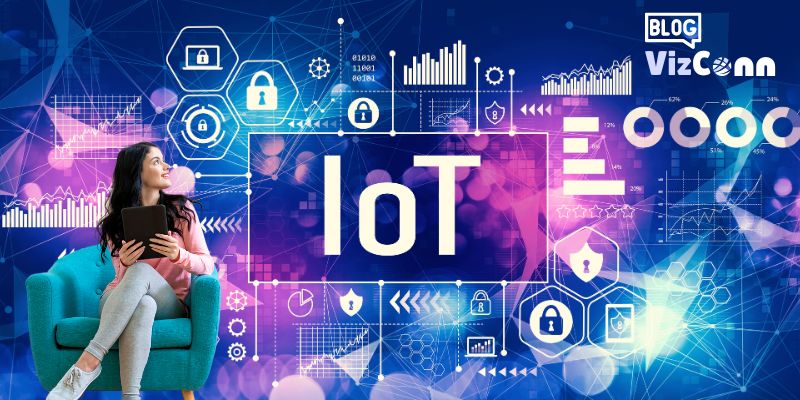

The Internet of Things (IoT) has emerged as an extraordinary force, transforming businesses and transforming our interactions with technology. At its foundation, IoT refers to an
interconnected network of devices, from smartphones and smart household appliances to industrial machinery and medical devices that communicate and exchange data via the internet.
This integrated ecosystem enables seamless communication and data interchange, paving the way for creative solutions that improve efficiency, productivity, and convenience across a
variety of industries.
IoT in Healthcare:
In the healthcare industry, IoT technology is delivering major improvements in patient care, treatment outcomes, and operational efficiency. This can be witness in our day to day
lives with the emergence of fitness trackers in the form of smart watches. Wearable fitness trackers, such as the Fitbit, Galaxy Watch and Apple Watch, monitor users' heart rates,
activity levels, and sleep patterns, giving significant insights for anyone seeking to track their health and wellness goals. In hospitals, IoT-enabled medical devices like smart
infusion pumps and continuous glucose monitors increase patient safety by automatically alerting healthcare staff to potential problems and assuring prompt actions.
IoT in Smart Cities:
The whole idea of smart cities is upon using IoT technology to improve urban infrastructure, sustainability, and citizens' quality of life. In this regard, the city of Barcelona
has used IoT technologies such as smart streetlights and waste management systems to enhance energy efficiency and reduce environmental impact. Barcelona is able to maximize traffic
flow, reduce air pollution, and improve public safety by collecting and analyzing data from sensors installed across the city, resulting in a more livable and sustainable urban
environment for its citizens.
IoT in Manufacturing:
In the manufacturing sector, IoT is critical to the transition to Industry 4.0, which is defined as the integration of digital technology and automation into industrial processes.
For instance, Bosch Rexroth uses IoT-enabled sensors and predictive analytics to monitor equipment performance in real time and anticipate potential maintenance issues ahead of time.
Manufacturers can increase operational efficiency, reduce downtime, and optimize manufacturing processes by using IoT solutions, resulting in cost savings and a competitive edge.
IoT in Consumer Electronics:
The exponential rise of IoT devices in the consumer market has heralded a new era of connected living, in which everyday items are equipped with intelligence and connectivity.
Smart home technologies, such as the Amazon Echo and Google Nest, enable users to manage their lights, thermostats, and security systems with voice commands, increasing home ease
and automation. Similarly, IoT-enabled vehicles, such as Tesla's electric automobiles, use sensors and connectivity to provide sophisticated capabilities like autonomous driving and
over-the-air software upgrades, transforming the automotive industry and altering the driving experience for consumers.
IoT technology can enhance website functionality, user experience, and data analytics, offering new opportunities for innovation and customization in the digital space.
Here are a few examples:
Environmental Monitoring: An environmental organization's website can collect real-time data on air quality, pollution levels, and weather conditions via IoT devices. Visitors
to the website can examine interactive maps and visualizations of this data, allowing them to monitor environmental trends, track changes in their area, and stay informed about
environmental issues. This is especially relevant for businesses that sell air purifiers, humidifiers, and dehumidifiers. The website allows users to see the air quality, moisture,
and pollution levels in their location and make informed decisions about the things they require. This functionality will benefit the website's users while increasing sales.
Smart Retail and Inventory Management: An e-commerce website for a retail establishment can work with IoT-enabled inventory management systems. RFID tags or sensors connected
to products can communicate with the inventory database, allowing for real-time updates on inventory levels, product availability, and location tracking on the website. This enables
the website to provide correct stock information to clients, optimize supply chain logistics, and automate inventory replenishment procedures.
Establishments: Smart parking solutions use IoT technology to improve parking management and the entire visitor experience in a variety of locations, such as malls, theaters,
tradeshows, stadiums, airports, and more. Businesses and organizations can provide clients with real-time parking availability information by installing IoT sensors in parking lots
and integrating them into their websites. This allows customers to have a hassle-free experience when visiting destinations such as malls, theaters, stadiums, and airports, since they
can simply identify and travel to convenient parking lots. Smart parking solutions simplify the parking process and reduce congestion, and improve customer satisfaction. With
additional features such as reservation options, wayfinding assistance, and integration with navigation systems, smart parking technology offers a seamless and efficient parking
experience for visitors across a wide range of venues and destinations.

Deepak founded VizConn in 2011 and writes about Technology and Business. Got a question for Deepak? Let us know and we will pass it on to him. He responds to most questions via email.